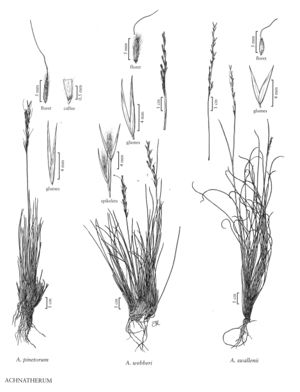Achnatherum webberi
Plants tightly cespitose, not rhizomatous. Culms 12-35 cm tall, 0.4-0.7 mm thick, smooth or antrorsely scabridulous; nodes 2-3. Basal sheaths glabrous, smooth or scabridulous; collars glabrous, without tufts of hair on the sides; basal ligules 0.1-1 mm, truncate to rounded; upper ligules 1-2 mm, acute; blades 0.5-1.5 mm wide when flat, usually folded to involute and about 0.5 mm in diameter, stiff, abaxial surfaces smooth or scabrous, adaxial surfaces scabrous. Panicles 2.5-7 cm long, 0.5-2 cm wide, contracted; branches appressed, longest branches 1-2 cm. Glumes subequal, 6-10 mm long, 0.6-0.9 mm wide, lanceolate, not saccate; florets 4.5-6 mm long, 0.7-1 mm thick, fusiform, terete; calluses 0.3-0.8 mm, blunt; lemmas evenly and densely pilose, hairs 2.5-3.5 mm, apical lobes 0.6-1.9 mm, membranous; awns 4-11 mm, readily deciduous, straight to once-geniculate, scabrous; paleas 4-5.6 mm, from as long as to slightly longer than the lemmas; anthers 1.6-2 mm, dehiscent, not penicillate. Caryopses 3.5-4.5 mm, fusiform. 2n = 32.
Distribution
Colo., Utah, Calif., Oreg., Idaho, Nev., S.Dak.
Discussion
Achnatherum webberi grows in dry, open flats and on rocky slopes, often with sagebrush, at 1500-2500 m. It grows at scattered locations from Oregon and Idaho to California and Nevada. It differs from A. hymenoides in its cylindrical floret and non-saccate glumes, and from A. pinetorum and A. parishii subsp. parishii in its shorter, deciduous awns. It also has narrower blades than A. parishii subsp. depauperatum.
Selected References
None.
Lower Taxa
"decumbent" is not a number."thick" is not a number."prolonged" is not a number.
